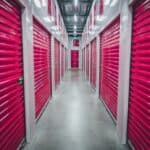Maintaining your self-storage facility is critical to safeguarding your belongings. While things like pest control and maintaining lighting might seem like something other than a top-of-mind priority, it is essential to customers who pay for ease and peace of mind protection for their belongings. Imagine a potential customer is touring the facility. They are impressed by the prices, 24/7 access, and online support, but they also notice the lack of cleanliness. In this case, this negative observation may lead this customer to choose a nearby competitor. Maintaining a well-kept and organized self-storage facility is crucial for ensuring your customers’ satisfaction and your business’s long-term success.
Self-Storage Maintenance To-Do List
Pest Control
Keeping pests at bay is essential for maintaining a clean and inviting storage environment. Seasonal pest problems may change depending on where your self-storage facility is located, but regular pest control measures should be a part of your maintenance routine regardless. Here are a few to-dos to help you maintain a pest-free facility:
- Conduct regular inspections for signs of pests.
- Seal any cracks or openings that pests can use to enter storage units.
- Implement a comprehensive pest control program in collaboration with professional exterminators.
- Educate tenants about proper storage practices to prevent pests.
Lighting Maintenance
Proper lighting is crucial for enhancing security, and it also plays a significant role in providing accessibility to your tenants. Here’s why lighting matters and how you can ensure optimal lighting in your facility:
- Well-lit areas deter potential intruders and enhance overall security.
- Install motion-sensor lights in key areas to conserve energy.
- Regularly inspect and replace faulty or dimming light fixtures.
- Consider using energy-efficient LED lighting for cost savings and longevity.
Security
Maintaining a safe environment for your patrons and their valuable belongings is of utmost importance. A secure facility protects your tenants and yourself. Here are some key security measures to consider:
- Install a comprehensive security system, including surveillance cameras, alarms, and access control systems.
- Regularly inspect and test security equipment to ensure it is functioning correctly.
- Train your staff on security protocols and emergency procedures as needed.
- Implement strict access control measures to prevent unauthorized entry.
Keeping Units Climate Controlled
Soothe tenant’s concerns about extreme temperatures with appropriate temperature and humidity levels. Here are some maintenance tips specific to climate-controlled facilities:
- Regularly inspect and service HVAC systems to ensure optimal performance.
- Monitor temperature and humidity levels using automated systems.
- Educate tenants about the importance of proper ventilation and temperature settings for their stored items.
- Implement backup power systems to prevent disruptions during power outages.
Preventing Mold and Mildew
Managing humidity levels is crucial in preventing mold and mildew growth, which can damage stored items and compromise the integrity of your facility. Here’s how you can address this issue:
- Install dehumidifiers in areas prone to excess moisture.
- Conduct regular inspections for signs of mold or mildew.
- Promptly address any water leaks or moisture issues.
- Ensure proper ventilation throughout the facility.
Cleaning and Repairs
Maintaining cleanliness and addressing repair needs as quickly as possible is important for creating a pleasant and functional storage environment. Here are some key points to consider:
- Develop a regular cleaning schedule for common areas and storage units.
- Address repairs such as broken doors, locks, or damaged walls quickly.
- Keep cleaning supplies and equipment readily available for staff use.
- Encourage tenants to maintain cleanliness in their individual units.
Preventative Measures
Regular self-storage inspections are crucial for identifying potential issues and preventing costly repairs in the long run. Here’s why preventative measures matter:
- Conduct routine inspections of storage units, common areas, and security systems.
- Address any maintenance issues promptly to prevent further damage.
- Document and keep records of inspections and repairs.
- Implement a proactive maintenance strategy to avoid costly repairs.
Guide to Self-Storage Maintenance
Maintaining a self-storage facility in top shape requires diligent attention to various aspects of maintenance. By following a comprehensive to-do list, you can ensure a safe and enjoyable experience for your customers. Additionally, by working with a remote management team, you can streamline facility maintenance, improve security, and optimize operational efficiency, all while saving time and money. Embrace these practices to set your self-storage facility on the path to long-term success.



